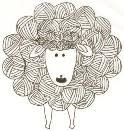I discovered an interesting fact last weekend - apparently some indie dyers regularly use the over dyeing or double dyeing technique to get a more complex hue.
I have often over-dyed if I haven't been happy with a result or have been disappointed with a yarn bought from a picture on the 'net'. It is amazing how a yarn colour can vary from monitor to monitor! Recently a friend was lucky enough to win some yarn in a competition run by Dragonfly Fibers and I was helping her choose her prize! I looked at their Orchid Thief once on my PC and once on my tablet and they looked completely different - on my PC the purple was more dominant and on my tablet it had a more magenta hue! Well she ordered a skein so it will be interesting to see which if either were right..
Double dyeing - is just that, the yarn is dye in a base colour and allowed to dry and then dye again with another colour! The only problem I see with this that the yarn loses something - the sample I saw didn't have the same vibrancy, although that may be due to the base yarn
So I tried myself - this skein was dyed a bright pink (DOS 4) and allowed to dye, I then re-whetted the skein and dyed with cyclamen at DOS 4 - result a deep purple but it does lack some of the vibrancy of a single dye yarn.
Another idiosyncrasy I have discovered is with singles, that is yarns that haven't been plied, is they need a different treatment to plied yarns - I don't know why, but I can show you the results
I am in the process of dyeing samples using all the Landscape dyes on 10 gram skeins of superwash merino. Similar to the samples I did mixing my own colours from the three primaries, but in this case I am dyeing four samples at depth of shade 1, 2,3 and 4 - that is using 10ml, 20ml, 30ml and 40ml of dye to each sample - simples yes!
The accountant in me thought I could save money by using 5 gram samples and halving the amount of dye solution - so I skein up 20 5 gram skeins, but by mistake I used a skein of singles rather than my usual plied merino and what a difference
These two samples are dye with Landscape Pacific - the top one is on the plied yarn and the bottom one on singles, both are superwash yarn. The top is a uniform colour and the singles are patchy lots of bits with no dye, some places darker - all very disappointing. But, and here's the crunch, I have a couple of commissions to dye singles for a customer - and if this sample is anything to go by neither she or I would be very happy.
I have been running all sorts of idea through my head as to why this might be happening. As this sampling method has worked and is working on plied yarn the difference must be in the manufacture of the yarn. Singles are exactly what they say they are - a single strand of spun fibre which has been spun with a little extra twist to help it hold together and slightly felted to help it hold together - as a single hasn't had the twist set by plying.
Is it the extra twist - the bottom sample has far more twist than the top, so does the yarn twist up in the dye bath preventing the dye reaching all the yarn. I wonder whether it might be an idea to give the yarn a good wash in case there are any oils from the spinning process still in the yarn - that seems a bit far fetched, but I am clutching at straws.
Here I have to say Google has failed to come up with an answer, despite using various search criteria - 'uneven take up when dyeing singles yarn' - zero, but lots of hits for how to spin singles ...
I have four skeins of singles which I am going dye with Kingfisher (or Madtosh's Button Jar Blue) - first I am going to soak the yarn in very hot water with some Soak and allow to drip weighted to hopefully straighten out some of the kinks before going on to the dyeing process.
More later.................
Saturday, 21 June 2014
Subscribe to:
Post Comments (Atom)






No comments:
Post a Comment
Note: only a member of this blog may post a comment.